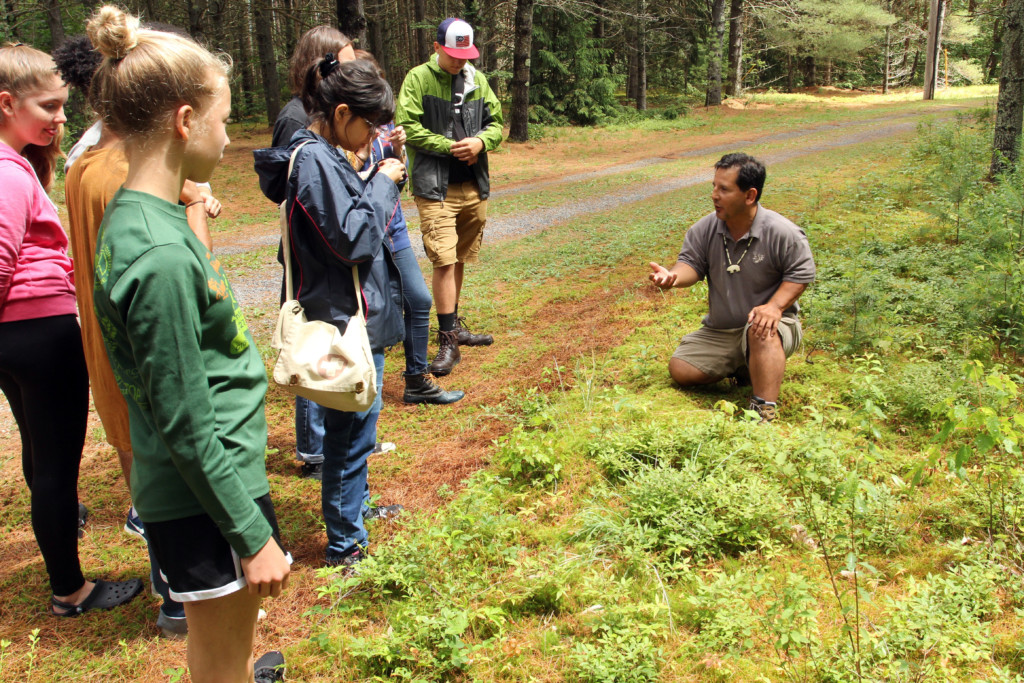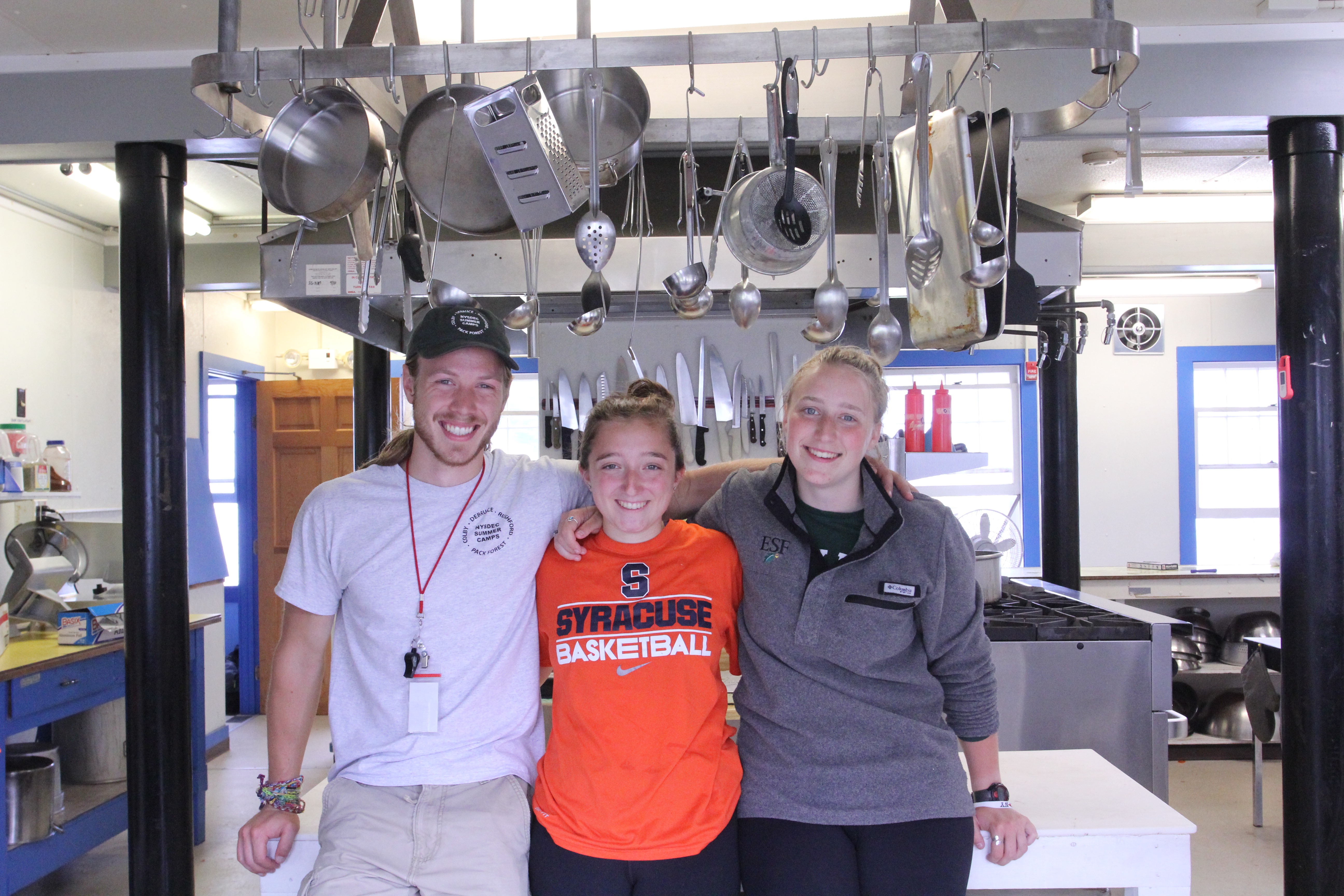Story by Claire B. Dunn
M idway through a muggy July morning, 10 teenagers at a summer camp in the Adirondacks walked along a trail covered with pine needles, stopping every few steps to learn something about nature and Native American crafts. They talked about what differentiates a white pine from a red one and what species of trees produce materials that make sturdy canoes. Their teacher was Neil Patterson, the assistant director of the ESF Center for Native Peoples and the Environment.
Another group of campers had opted for a float trip on the Hudson River. Helping lead that adventure were counselors Corey Adamshick, a member of the ESF Class of 2017, and Tessa Janicke, who graduated from ESF in 2016.
The campers and counselors had set out for their morning sessions after a breakfast prepared, in part, by Emma Gilroy, now a first-year student at ESF, and Renee Perrotte, an ESF junior.
And organizing all of them that July morning was Ryan Hicks, an enthusiastic ESF senior who worked as the assistant camp director.
The scene was ESF’s Charles Lathrop Pack Demonstration Forest in Warrensburg, New York, where the New York State Department of Environmental Conservation (DEC) has run an Environmental Education Camp since 1998. The camp serves about 50 campers each week.
“Charles Lathrop Pack’s idea was to have these demonstration sites all over the country. He was big into education. That was his thing,” said Bruce Breitmeyer, Adirondack forest properties manager for ESF. “We are carrying on his legacy of education with this camp partnership.”
Share
For more information about the DEC’s summer camps at Pack Forest and other locations around the state, visit www.dec.ny.gov/education/29.html. Online registration for 2018 will open in mid-January, and weeks fill up fast.

Neil Patterson, assistant director of the ESF Center for Native Peoples and the Environment, teaches campers about using items found in nature to make Native American crafts.
This year marks the 2,600-acre property’s 90th year as part of the extended College campus. The property was deeded to the College on Oct. 19, 1927, by Pack, a wealthy timberman, and his wife, the former Alice Gertrude Hatch. The property includes an 85-acre lake and miles of trails leading to mountain vistas, marshes and the banks of the Hudson River.
The forest has been used by ESF for several purposes, including demonstration projects and as the location of the traditional forestry Summer Camp.
The DEC also runs Camp Colby in Franklin County, DeBruce in the southern Catskills and Rushford in Allegany County for campers ages 11 to 13. Rushford and Pack Forest also have weeks for campers ages 14 to 17. The camps focus on environmental education, sportsman education and outdoor fun. About 10 ESF students and young alumni were employed throughout the camp network this past summer; five of them worked at Pack Forest. Faculty and staff members also get involved. The same day Patterson was sharing lessons in Native American crafts as part of a special Outdoor Adventure Week, the students had a visit from Dr. David Newman, chair of the ESF Department of Forest and Natural Resources Management, who participated in an evening college information session.
The ESF ethos is evident at Pack Forest, where young campers live and learn on ESF property under the tutelage of counselors who are ESF students; many of them were once campers themselves.
“It’s quite common for our counselors to start as campers,” said Ann Harrison, chief of the DEC’s Bureau of Environmental Education. “They see what a cool job it is and they come back to work here.”
Click on the images above to view in a slideshow
They also learn about ESF. Gilroy, in her first year as a camp employee, said her counselors shaped her interest in the College as the camp was shaping her career interests.
“I’m going to ESF because of camp. Half the staff here goes to ESF. It’s really been talked up for the last few years,” she said. “Basically, everything I want to do with my life is because of this.”
Gilroy, who plans to major in environmental biology, said she has been interested in environmental issues since she was a third grader policing her classmates’ use of the trashcan. She would redirect them to the recycle bins when she thought it was appropriate. “Then I came here and found out everyone else was exactly like me,” she said.
One of Gilroy’s former counselors is Hicks, who first came to the camp at age 13 and returned as a volunteer before working as a counselor and moving up to the position of assistant director. Hicks is majoring in sustainable energy management.
He said his leadership job at camp relates to his interest in management. He has taught the campers lessons related to energy use in the natural food web. “It was a good lesson,” Gilroy interjected.
“With the school’s motto being ‘Improve Your World,’ you see that being here is one of the best ways to do that,” Hicks said. “There’s nothing like being there when a kid catches a fish for the first time. You can change a kid’s life here. We don’t teach kids to love the environment here but we do facilitate it.”












